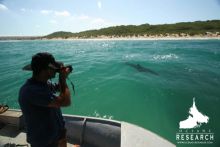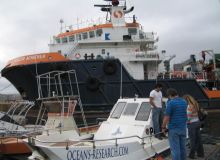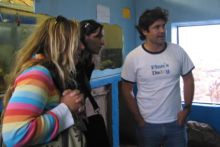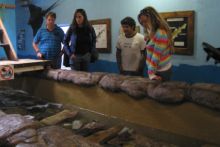SAEON Egagasini investigates future collaboration with Oceans Research
|
In October, SAEON Egagasini staff members Dr Juliet Hermes, Dr Lara Atkinson, Dr Wayne Goschen and Fiona Cuff visited Mossel Bay. The trip resulted from an enquiry from Oceans Research, which is based in Mossel Bay, into SAEON’s operations as well as possible collaborations in the future.
On arrival in Mossel Bay the group met with Ryan Johnson, Head of Research, Simon Elwen, Research Affiliate and Enrico Gennari, Laboratory Director. They were also introduced to the other staff members and students.
The meeting was very informative for both parties. Ryan explained the type of research the group is involved in, how the group is run and where they obtain their funding from. Oceans Research focuses on top predators in the Mossel Bay area, largely in terms of various impacts in the bay such as aquaculture and the desalination plant. They have memoranda of understanding in place with Rhodes University, the University of Cape Town (UCT) and the South African Institute for Aquatic Biodiversity (SAIAB).
Oceans Research relies on student internship programmes for most of their funding which is used for fieldwork and projects. The students are given practical hands-on field-based training in data collection under the supervision of a principal investigator. They are rotated between the various projects and generally stay on for two to four months. Postgraduate students occasionally return to continue their research. Oceans Research funds and assists with their field-based work, but the students are required to cover other applicable costs themselves.
Oceans Research owns three vessels with various equipment which they launch 10 to 15 times a week for research on sharks. They mostly look at benthic, white and ragged-tooth sharks. Dolphin tracking is conducted from the shore to investigate key habitat areas of use in the bay.
The group is moreover involved in a tag-release programme with the Oceanographic Research Institute and some stable isotope work with the Department of Environmental Affairs. Oceans Research will be working on the Ocean Tracking Network (OTN) when it is deployed in the Mossel Bay area. This project involves installing pinger receivers (underwater acoustical tracking systems) around the coast of South Africa to monitor the movement of tagged fish and sharks. The pingers also record depth, position and temperature.
Long-term environmental monitoring
At present, Oceans Research is not conducting any specific long-term environmental monitoring, but expressed interest in starting an initiative. They have been in discussions with UCT regarding collaborations to do long-term monitoring of the physical oceanographic parameters around the desalination plant and to investigate possible impacts of the plant on the dolphins, whales and sharks in the bay.
The meeting was followed by a tour of Oceans Research’s facilities, beginning with the residence where the internship students stay. The group then proceeded to the harbour to view Oceans Research’s three research vessels and to the shark aquarium and research facility (The Shark Lab) where experiments are conducted to monitor behaviour, population and ecophysiology of mostly smaller benthic catsharks.
The next day Juliet, Lara and Fiona visited Oceans Research for a final meeting. The suggestion was for Oceans Research to write a proposal for possible collaboration. SAEON indicated that they would be able to assist Oceans Research with their database and house it on the SAEON data portal. Collaborations with regard to long-term environmental monitoring were also mentioned.
Overall, the trip was a successful exploration of the research conducted by Oceans Research. Future plans for collaboration will be investigated.







